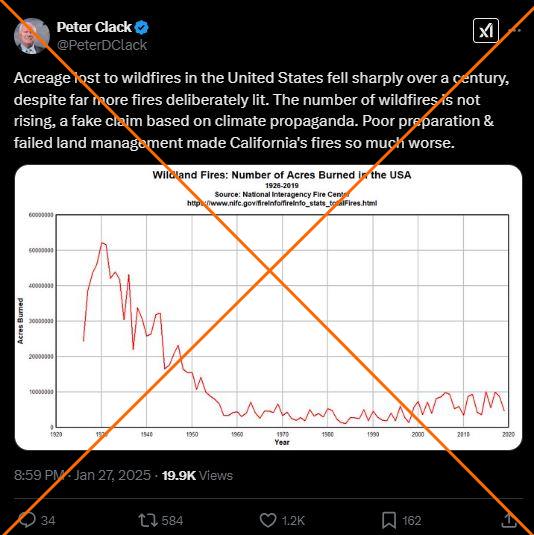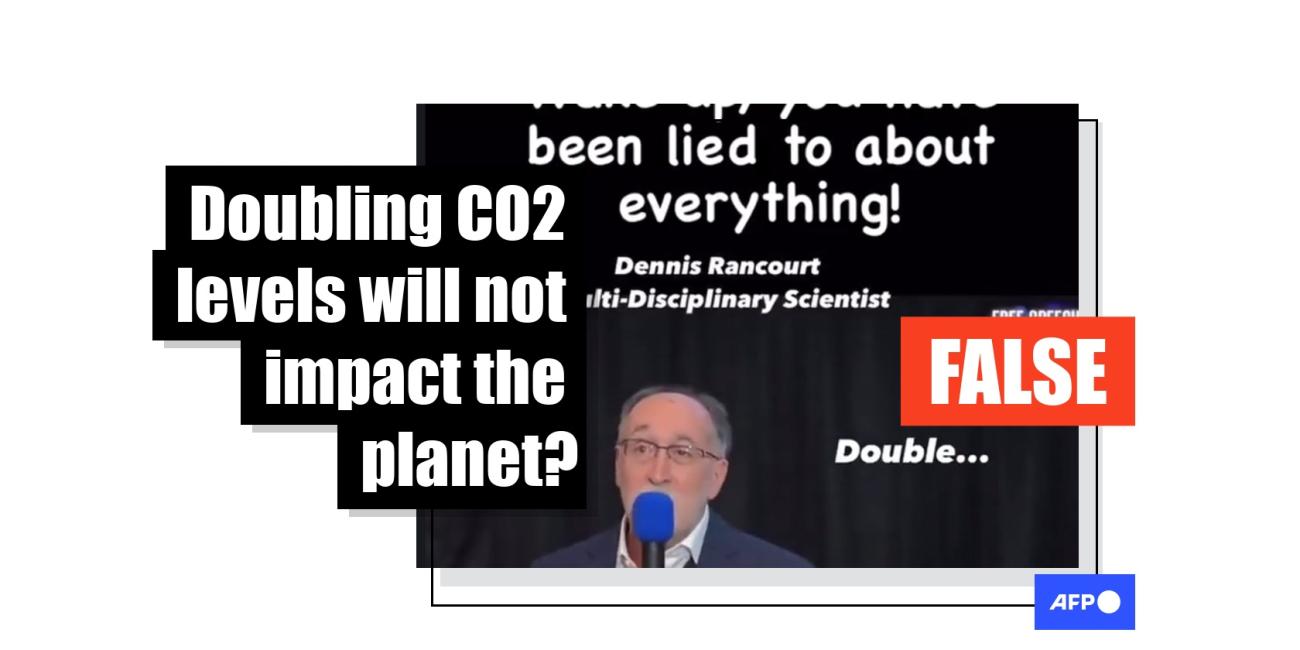
US wildfire data misused following devastating LA wildfires
- Published on February 10, 2025 at 22:02
- 3 min read
- By Manon JACOB, AFP USA
Following devastating Southern California blazes in January 2025, a post on X claimed US acreage lost to wildfires is decreasing compared with historical data. This is misleading; scientists say records prior to 1983 are unreliable and that climate change in recent years has created conditions for more intense, fast-spreading blazes in the United States.
"Acreage lost to wildfires in the United States fell sharply over a century, despite far more fires deliberately lit. The number of wildfires is not rising, a fake claim based on climate propaganda," a January 27, 2025 post on X by Australian author Peter Clack claims.
In his post, Clack shares a chart -- initially crafted by previously debunked climate-skeptic Anthony Watts -- created by combining official statistics (archived here) currently visible on the US National Interagency Fire Center (NIFC) covering 1983 to the present -- which show an upward trend in US wildfires -- with unofficial data covering a longer timeframe.
Similar narratives have previously circulated on social media, purporting official data has been manipulated to exaggerate observed historical trends. The charts suggest acreage lost peaked around 1930 at levels much higher than in recent years.

But the NIFC clearly states on its website: "Prior to 1983, the federal wildland fire agencies did not track official wildfire data using current reporting processes. As a result, there is no official data prior to 1983 posted on this site."
US Department of Agriculture Forest Service Research ecologist, Karen Short (archived here), reported on bias and inconsistencies in older statistics in a 2015 paper (archived here).
Millions of acres of intentional burns in the United States used to be included as part of the annual estimates of wildfire activity on unprotected lands, she noted.
In particular, she pointed to prescribed burns that are not currently considered or tracked as wildfires under current criteria but were included in estimates of the acres lost to fire in three southeastern states.
More acres, faster burns
The US Bureau of Land Management also told AFP that the data prior to 1983 is not reliable and said recent datasets point to concerning signs of more intense fire seasons in the country.
Between 1983 and 2004, an average of fewer than 4 million acres burned per year, but in recent decades more than 6 million acres burned annually even though the number of wildfires did not substantially increase, according to the US Bureau of Land Management.
During that period, a slight "reduction in number of fires but increase in acres burned shows a growing trend of larger fires that have become more difficult to suppress," Brian Hires, a spokesman for the agency, told AFP on February 5.
Propagation speed is another key factor in tracking how warming trends impact fire seasons in the US, scientists say (archived here). Fires get supercharged by warming trends as vegetation transitions to more flammable fuels amid weather whiplash -- a growing phenomenon documented in California (archived here).
Numbers predating 1983 "should be treated very carefully and skeptically," Keith Weber, a wildfire researcher at Idaho State University, told AFP on February 4.
"Fire frequency, fire size, and the number of megafires (100,000 acres or more) is trending upward," he explained.
Human-induced warming has led to longer fire seasons, increasing the risks of wildfire including in the western United States (archived, here).
However, he noted, while climate and weather "can and do play a role, so does decades of past fire suppression (resulting in fuel stockpiles), invasive grasses, and land management practices" that have also contributed to fueling wildfires.
The Palisades and Eaton fires that ravaged Los Angeles County were the most destructive in the history of the second-largest US city, burning some 37,000 acres (150 square kilometers). The blazes killed about 30 people and displaced thousands more, with hundreds of billions of dollars in estimated damage to property and more than 10,000 homes destroyed.
AFP has debunked other misleading claims about the California wildfires.
Copyright © AFP 2017-2025. Any commercial use of this content requires a subscription. Click here to find out more.
Is there content that you would like AFP to fact-check? Get in touch.
Contact us




